HYUNDAI VERACRUZ 2012 Owner's Guide
Manufacturer: HYUNDAI, Model Year: 2012, Model line: VERACRUZ, Model: HYUNDAI VERACRUZ 2012Pages: 429, PDF Size: 7.11 MB
Page 31 of 429
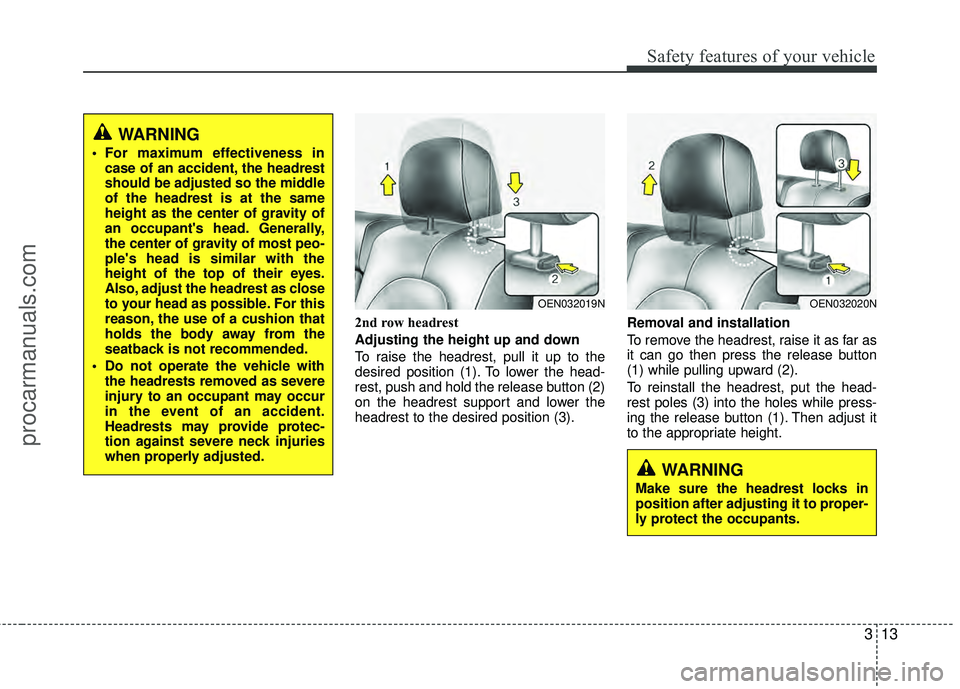
313
Safety features of your vehicle
2nd row headrest
Adjusting the height up and down
To raise the headrest, pull it up to the
desired position (1). To lower the head-
rest, push and hold the release button (2)
on the headrest support and lower the
headrest to the desired position (3).Removal and installation
To remove the headrest, raise it as far as
it can go then press the release button
(1) while pulling upward (2).
To reinstall the headrest, put the head-
rest poles (3) into the holes while press-
ing the release button (1). Then adjust it
to the appropriate height.
OEN032020NOEN032019N
WARNING
For maximum effectiveness in
case of an accident, the headrest
should be adjusted so the middle
of the headrest is at the same
height as the center of gravity of
an occupant's head. Generally,
the center of gravity of most peo-
ple's head is similar with the
height of the top of their eyes.
Also, adjust the headrest as close
to your head as possible. For this
reason, the use of a cushion that
holds the body away from the
seatback is not recommended.
Do not operate the vehicle with the headrests removed as severe
injury to an occupant may occur
in the event of an accident.
Headrests may provide protec-
tion against severe neck injuries
when properly adjusted.
WARNING
Make sure the headrest locks in
position after adjusting it to proper-
ly protect the occupants.
procarmanuals.com
Page 32 of 429
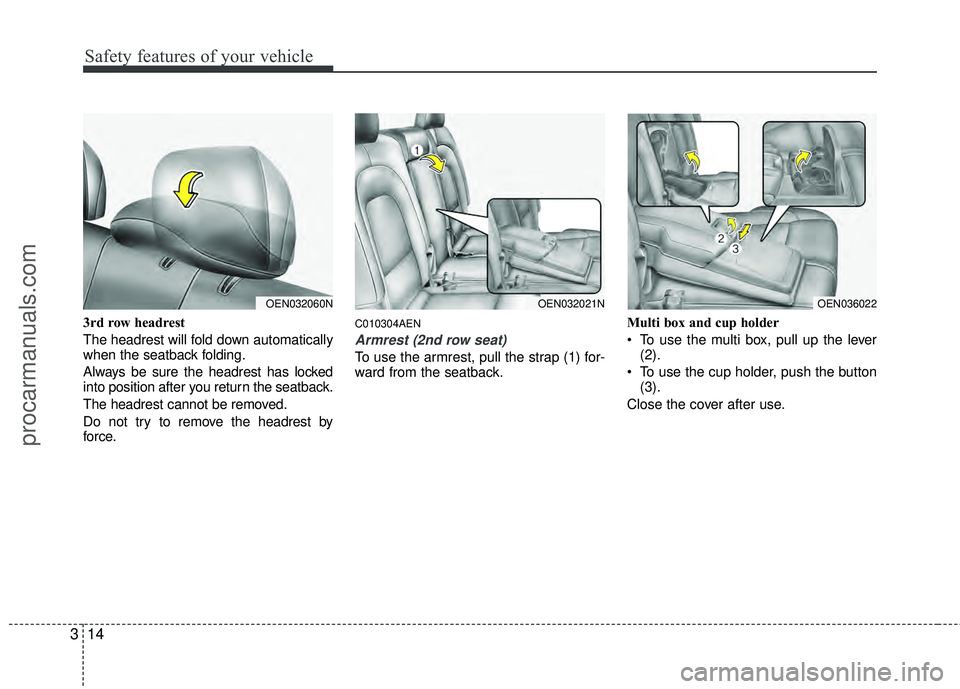
Safety features of your vehicle
14
3
3rd row headrest
The headrest will fold down automatically
when the seatback folding.
Always be sure the headrest has locked
into position after you return the seatback.
The headrest cannot be removed.
Do not try to remove the headrest by
force.C010304AEN
Armrest (2nd row seat)
To use the armrest, pull the strap (1) for-
ward from the seatback. Multi box and cup holder
To use the multi box, pull up the lever
(2).
To use the cup holder, push the button (3).
Close the cover after use.
OEN036022OEN032021NOEN032060N
procarmanuals.com
Page 33 of 429
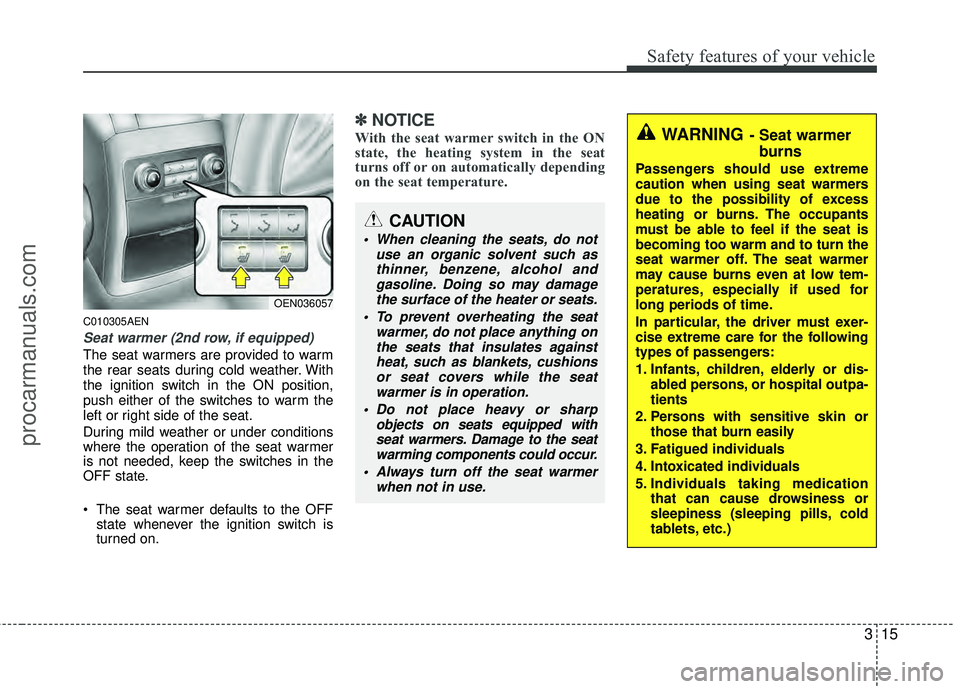
315
Safety features of your vehicle
C010305AEN
Seat warmer (2nd row, if equipped)
The seat warmers are provided to warm
the rear seats during cold weather. With
the ignition switch in the ON position,
push either of the switches to warm the
left or right side of the seat.
During mild weather or under conditions
where the operation of the seat warmer
is not needed, keep the switches in the
OFF state.
The seat warmer defaults to the OFFstate whenever the ignition switch is
turned on.
✽ ✽ NOTICE
With the seat warmer switch in the ON
state, the heating system in the seat
turns off or on automatically depending
on the seat temperature.
OEN036057
CAUTION
When cleaning the seats, do not
use an organic solvent such asthinner, benzene, alcohol andgasoline. Doing so may damage the surface of the heater or seats.
To prevent overheating the seat warmer, do not place anything onthe seats that insulates againstheat, such as blankets, cushionsor seat covers while the seatwarmer is in operation.
Do not place heavy or sharp objects on seats equipped withseat warmers. Damage to the seatwarming components could occur.
Always turn off the seat warmer when not in use.
WARNING- Seat warmerburns
Passengers should use extreme
caution when using seat warmers
due to the possibility of excess
heating or burns. The occupants
must be able to feel if the seat is
becoming too warm and to turn the
seat warmer off. The seat warmer
may cause burns even at low tem-
peratures, especially if used for
long periods of time.
In particular, the driver must exer-
cise extreme care for the following
types of passengers:
1. Infants, children, elderly or dis-
abled persons, or hospital outpa-
tients
2. Persons with sensitive skin or those that burn easily
3. Fatigued individuals
4. Intoxicated individuals
5. Individuals taking medication that can cause drowsiness or
sleepiness (sleeping pills, cold
tablets, etc.)
procarmanuals.com
Page 34 of 429
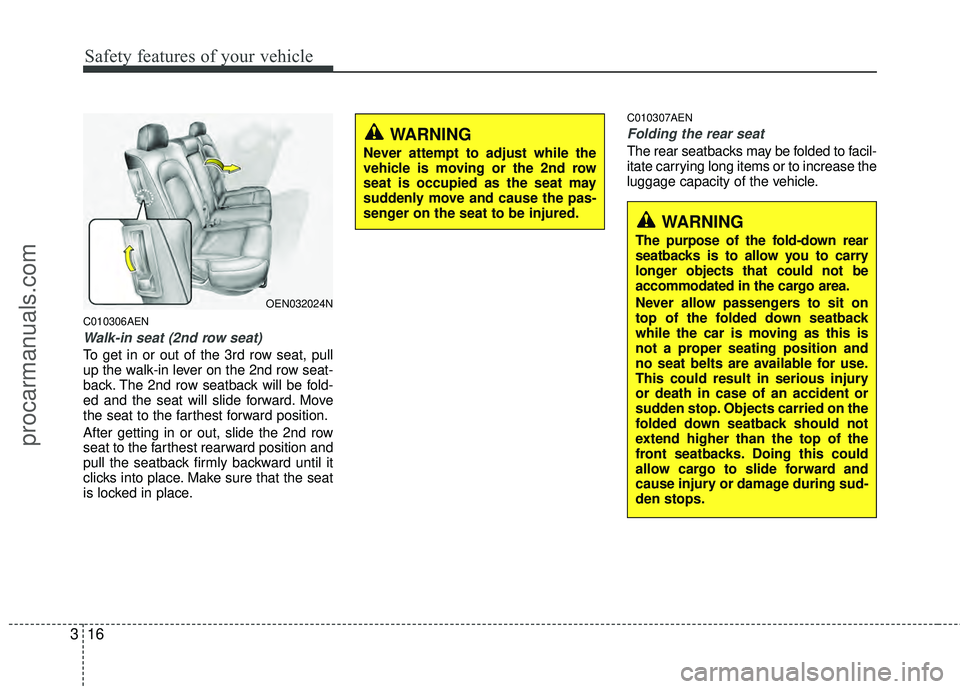
Safety features of your vehicle
16
3
C010306AEN
Walk-in seat (2nd row seat)
To get in or out of the 3rd row seat, pull
up the walk-in lever on the 2nd row seat-
back. The 2nd row seatback will be fold-
ed and the seat will slide forward. Move
the seat to the farthest forward position.
After getting in or out, slide the 2nd row
seat to the farthest rearward position and
pull the seatback firmly backward until it
clicks into place. Make sure that the seat
is locked in place.
C010307AEN
Folding the rear seat
The rear seatbacks may be folded to facil-
itate carrying long items or to increase the
luggage capacity of the vehicle.
WARNING
The purpose of the fold-down rear
seatbacks is to allow you to carry
longer objects that could not be
accommodated in the cargo area.
Never allow passengers to sit on
top of the folded down seatback
while the car is moving as this is
not a proper seating position and
no seat belts are available for use.
This could result in serious injury
or death in case of an accident or
sudden stop. Objects carried on the
folded down seatback should not
extend higher than the top of the
front seatbacks. Doing this could
allow cargo to slide forward and
cause injury or damage during sud-
den stops.
WARNING
Never attempt to adjust while the
vehicle is moving or the 2nd row
seat is occupied as the seat may
suddenly move and cause the pas-
senger on the seat to be injured.
OEN032024N
procarmanuals.com
Page 35 of 429
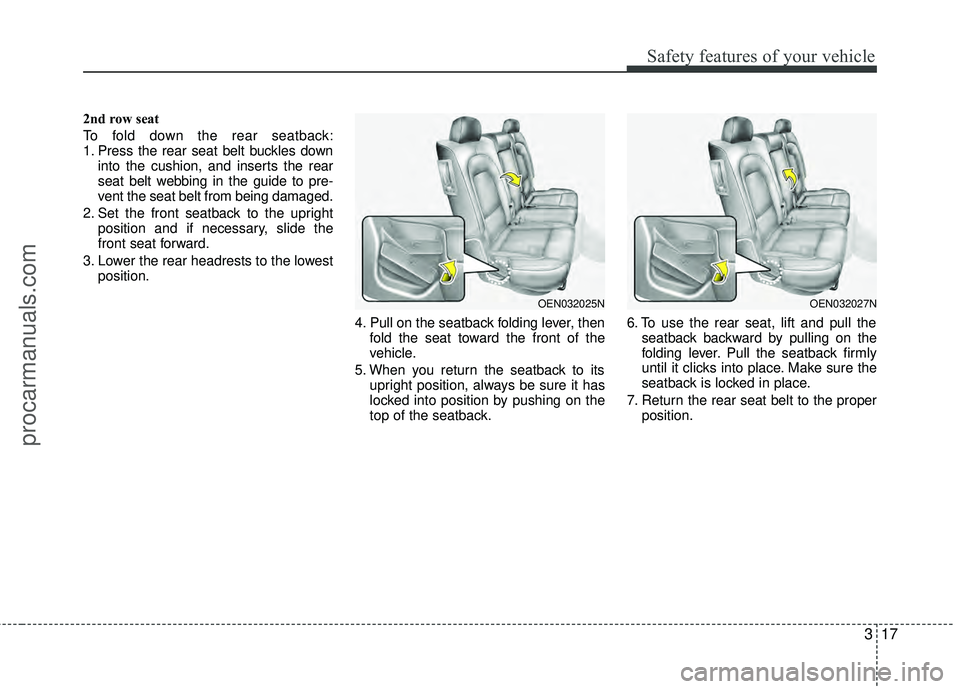
317
Safety features of your vehicle
2nd row seat
To fold down the rear seatback:
1. Press the rear seat belt buckles downinto the cushion, and inserts the rear
seat belt webbing in the guide to pre-
vent the seat belt from being damaged.
2. Set the front seatback to the upright position and if necessary, slide the
front seat forward.
3. Lower the rear headrests to the lowest position.
4. Pull on the seatback folding lever, thenfold the seat toward the front of the
vehicle.
5. When you return the seatback to its upright position, always be sure it has
locked into position by pushing on the
top of the seatback. 6. To use the rear seat, lift and pull the
seatback backward by pulling on the
folding lever. Pull the seatback firmly
until it clicks into place. Make sure the
seatback is locked in place.
7. Return the rear seat belt to the proper position.
OEN032025NOEN032027N
procarmanuals.com
Page 36 of 429
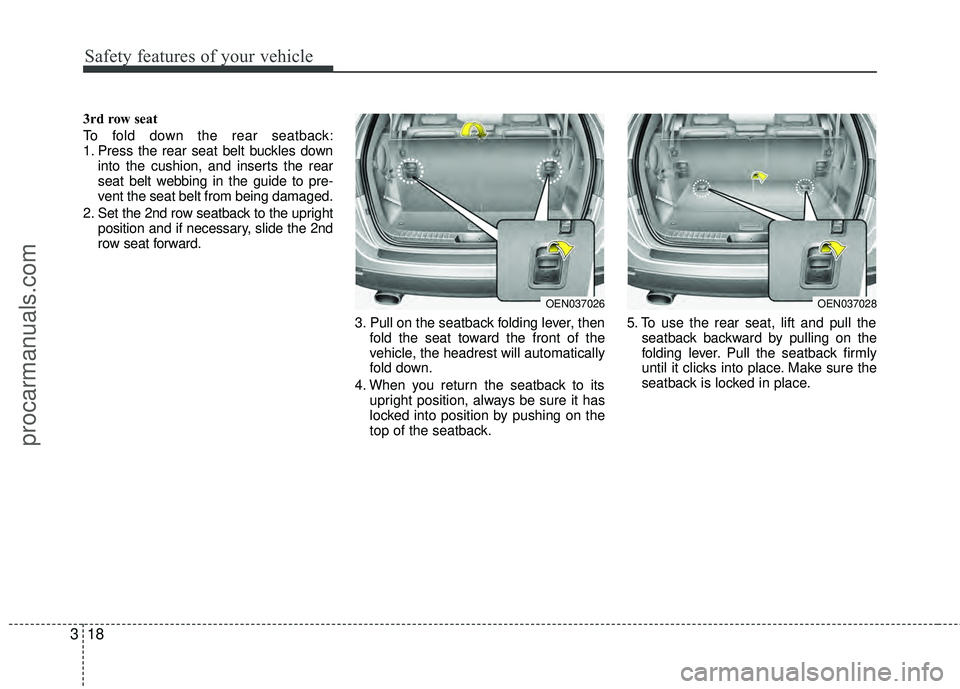
Safety features of your vehicle
18
3
3rd row seat
To fold down the rear seatback:
1. Press the rear seat belt buckles down
into the cushion, and inserts the rear
seat belt webbing in the guide to pre-
vent the seat belt from being damaged.
2. Set the 2nd row seatback to the upright position and if necessary, slide the 2nd
row seat forward.
3. Pull on the seatback folding lever, thenfold the seat toward the front of the
vehicle, the headrest will automatically
fold down.
4. When you return the seatback to its upright position, always be sure it has
locked into position by pushing on the
top of the seatback. 5. To use the rear seat, lift and pull the
seatback backward by pulling on the
folding lever. Pull the seatback firmly
until it clicks into place. Make sure the
seatback is locked in place.
OEN037026OEN037028
procarmanuals.com
Page 37 of 429
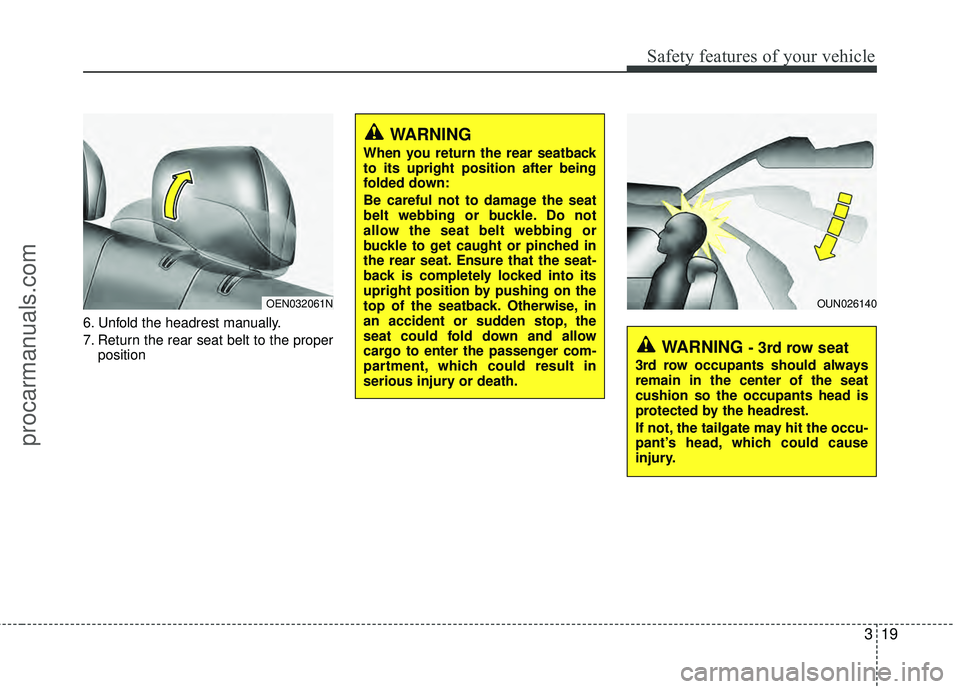
319
Safety features of your vehicle
6. Unfold the headrest manually.
7. Return the rear seat belt to the properposition
WARNING
When you return the rear seatback
to its upright position after being
folded down:
Be careful not to damage the seat
belt webbing or buckle. Do not
allow the seat belt webbing or
buckle to get caught or pinched in
the rear seat. Ensure that the seat-
back is completely locked into its
upright position by pushing on the
top of the seatback. Otherwise, in
an accident or sudden stop, the
seat could fold down and allow
cargo to enter the passenger com-
partment, which could result in
serious injury or death.
OEN032061NOUN026140
WARNING - 3rd row seat
3rd row occupants should always
remain in the center of the seat
cushion so the occupants head is
protected by the headrest.
If not, the tailgate may hit the occu-
pant’s head, which could cause
injury.
procarmanuals.com
Page 38 of 429

Safety features of your vehicle
20
3
WARNING - Uprighting
seat
When you return the seatback to its
upright position, hold the seatback
and return it slowly. If the seatback
is returned without holding it, the
back of the seat could spring for-
ward resulting in injury caused by
being struck by the seatback.
WARNING- Cargo
Cargo should always be secured to
prevent it from being thrown about
the vehicle in a collision and caus-
ing injury to the vehicle occupants.
Do not place objects on the rear
(2nd and/or 3rd row) seats, since
they cannot be properly secured
and may hit the front seat occu-
pants in a collision.
WARNING - Cargo loading
Make sure the engine is off, the
automatic transaxle is in P (Park)
or the manual transaxle is in
reverse, and the parking brake is
securely applied whenever loading
or unloading cargo. Failure to take
these steps may allow the vehicle
to move if the shift lever is inadver-
tently moved to another position.
CAUTION- Rear seat belts
When returning the rear (2nd and/or
3rd row) seatbacks to the uprightposition, remember to return the rearshoulder belts to their proper posi-tion. Routing the seat belt webbing through the rear seat belt guides willhelp keep the belts from being trapped behind or under the seats.
CAUTION - Damaging rear
seat belt buckles
When you fold the rear (2nd and/or
3rd row) seatback, push the buckleinto the pocket in the rear cushion.Doing so can prevent the buckle frombeing damaged by the rear seatback.
procarmanuals.com
Page 39 of 429
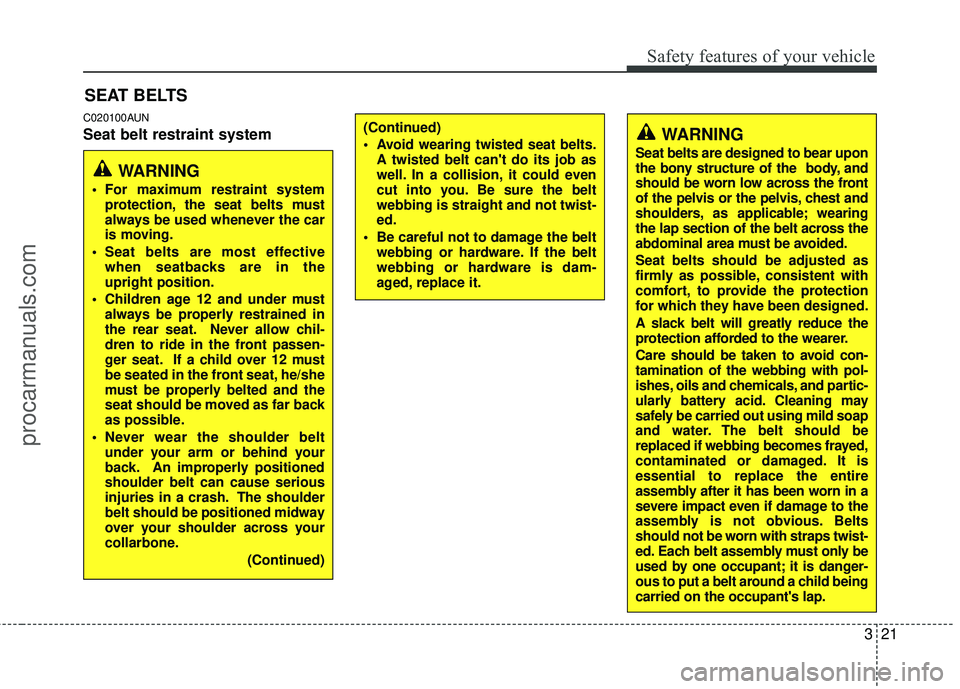
321
Safety features of your vehicle
C020100AUN
Seat belt restraint system
SEAT BELTS
WARNING
Seat belts are designed to bear upon
the bony structure of the body, and
should be worn low across the front
of the pelvis or the pelvis, chest and
shoulders, as applicable; wearing
the lap section of the belt across the
abdominal area must be avoided.
Seat belts should be adjusted as
firmly as possible, consistent with
comfort, to provide the protection
for which they have been designed.
A slack belt will greatly reduce the
protection afforded to the wearer.
Care should be taken to avoid con-
tamination of the webbing with pol-
ishes, oils and chemicals, and partic-
ularly battery acid. Cleaning may
safely be carried out using mild soap
and water. The belt should be
replaced if webbing becomes frayed,
contaminated or damaged. It is
essential to replace the entire
assembly after it has been worn in a
severe impact even if damage to the
assembly is not obvious. Belts
should not be worn with straps twist-
ed. Each belt assembly must only be
used by one occupant; it is danger-
ous to put a belt around a child being
carried on the occupant's lap.
(Continued)
Avoid wearing twisted seat belts.A twisted belt can't do its job as
well. In a collision, it could even
cut into you. Be sure the belt
webbing is straight and not twist-
ed.
Be careful not to damage the belt webbing or hardware. If the belt
webbing or hardware is dam-
aged, replace it.
WARNING
For maximum restraint systemprotection, the seat belts must
always be used whenever the car
is moving.
Seat belts are most effective when seatbacks are in the
upright position.
Children age 12 and under must always be properly restrained in
the rear seat. Never allow chil-
dren to ride in the front passen-
ger seat. If a child over 12 must
be seated in the front seat, he/she
must be properly belted and the
seat should be moved as far back
as possible.
Never wear the shoulder belt under your arm or behind your
back. An improperly positioned
shoulder belt can cause serious
injuries in a crash. The shoulder
belt should be positioned midway
over your shoulder across your
collarbone.
(Continued)
procarmanuals.com
Page 40 of 429
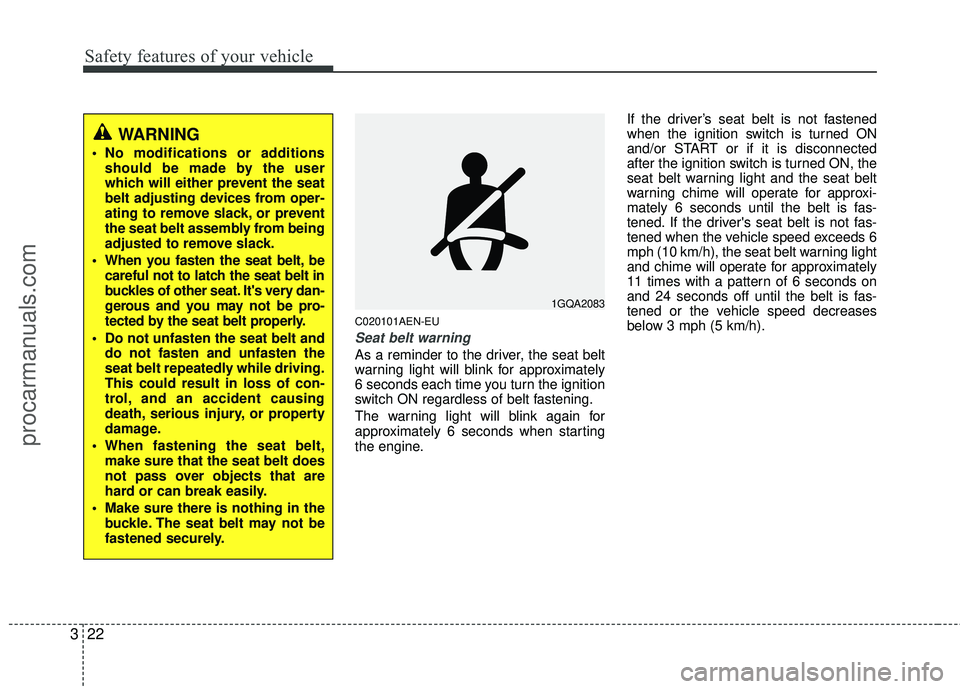
Safety features of your vehicle
22
3
C020101AEN-EU
Seat belt warning
As a reminder to the driver, the seat belt
warning light will blink for approximately
6 seconds each time you turn the ignition
switch ON regardless of belt fastening.
The warning light will blink again for
approximately 6 seconds when starting
the engine. If the driver’s seat belt is not fastened
when the ignition switch is turned ON
and/or START or if it is disconnected
after the ignition switch is turned ON, the
seat belt warning light and the seat belt
warning chime will operate for approxi-
mately 6 seconds until the belt is fas-
tened. If the driver's seat belt is not fas-
tened when the vehicle speed exceeds 6
mph (10 km/h), the seat belt warning light
and chime will operate for approximately
11 times with a pattern of 6 seconds on
and 24 seconds off until the belt is fas-
tened or the vehicle speed decreases
below 3 mph (5 km/h).
1GQA2083
WARNING
No modifications or additions
should be made by the user
which will either prevent the seat
belt adjusting devices from oper-
ating to remove slack, or prevent
the seat belt assembly from being
adjusted to remove slack.
When you fasten the seat belt, be careful not to latch the seat belt in
buckles of other seat. It's very dan-
gerous and you may not be pro-
tected by the seat belt properly.
Do not unfasten the seat belt and do not fasten and unfasten the
seat belt repeatedly while driving.
This could result in loss of con-
trol, and an accident causing
death, serious injury, or property
damage.
When fastening the seat belt, make sure that the seat belt does
not pass over objects that are
hard or can break easily.
Make sure there is nothing in the buckle. The seat belt may not be
fastened securely.
procarmanuals.com